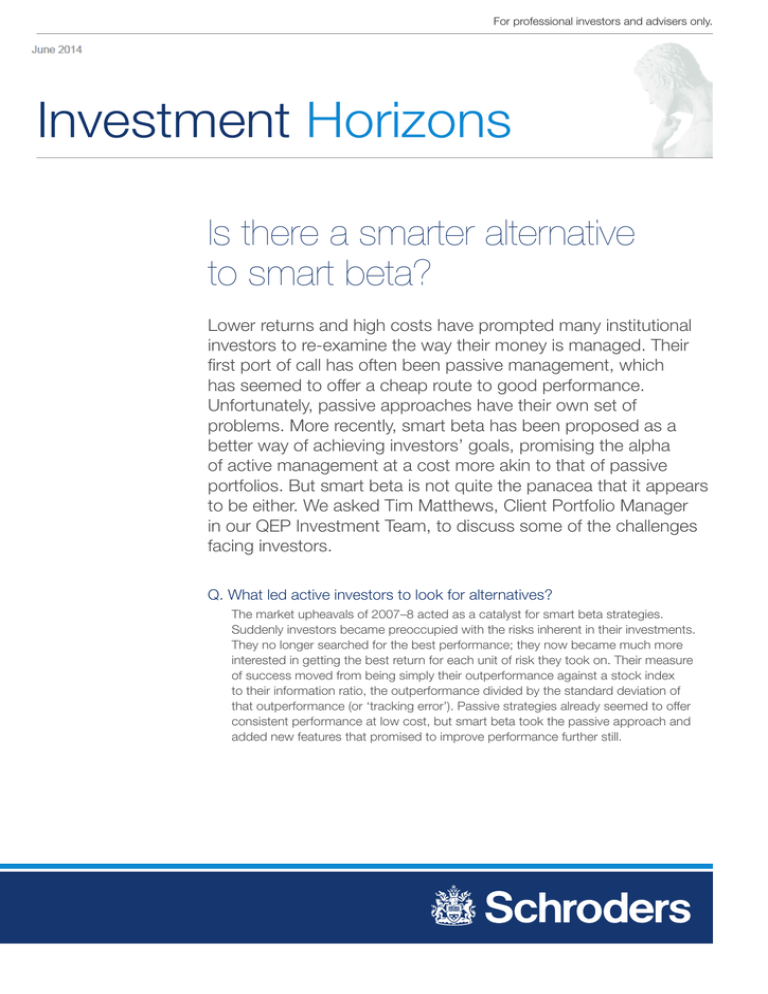Investment Horizons Is there a smarter alternative to smart beta?
advertisement

For professional investors and advisers only. April 2014 1 Investment Horizons Is there a smarter alternative to smart beta? Lower returns and high costs have prompted many institutional investors to re-examine the way their money is managed. Their first port of call has often been passive management, which has seemed to offer a cheap route to good performance. Unfortunately, passive approaches have their own set of problems. More recently, smart beta has been proposed as a better way of achieving investors’ goals, promising the alpha of active management at a cost more akin to that of passive portfolios. But smart beta is not quite the panacea that it appears to be either. We asked Tim Matthews, Client Portfolio Manager in our QEP Investment Team, to discuss some of the challenges facing investors. Q. What led active investors to look for alternatives? The market upheavals of 2007–8 acted as a catalyst for smart beta strategies. Suddenly investors became preoccupied with the risks inherent in their investments. They no longer searched for the best performance; they now became much more interested in getting the best return for each unit of risk they took on. Their measure of success moved from being simply their outperformance against a stock index to their information ratio, the outperformance divided by the standard deviation of that outperformance (or ‘tracking error’). Passive strategies already seemed to offer consistent performance at low cost, but smart beta took the passive approach and added new features that promised to improve performance further still. 2 Is there a smarter alternative to smart beta? Q. So what’s wrong with passive management? It’s important to be clear that there are many benefits to investing passively using traditional market-capitalisation benchmarks. They include diversification, transparency, and what can be a cheap way to gain access to the equity market. However, while passive strategies may be systematic and transparent in their construction, these features also make them inherently anti value, since they encourage investors to buy high and sell low. They can also lack breadth and effectively restrict the investor to the largest stocks in the investment universe. This concentration on the largest stocks means that the diversification benefits are often more apparent than real. Q. What do you mean by concentration? In certain market environments, market capitalisation weighted indices are dominated by a relatively small proportion of the market. For instance, in February 1989, 44% of the MSCI World Index – which represents the largest global stocks – was composed of Japanese stocks. In February 2000, technology and telecoms stocks made up over 35% of that same global index. In both cases, those two parts of the market – Japanese stocks and the technology and telecoms sector – underperformed badly in the subsequent period. Indeed, research shows that the larger and apparently safer stocks that often dominate cap-weighted indices generally tend to underperform in the long run. Q. And what about lack of breadth? We think index-bound investors restrict their investment choices unnecessarily. For instance, while the MSCI World Index is currently composed of over 1,600 stocks, we would argue that the universe of global stocks with sufficient liquidity to allow efficient access by investors comes to more than 15,000 stocks. This includes over 4,000 in emerging markets which are potentially attractive and suitably liquid, but are not represented in the MSCI World Index, restricted as it is to the developed markets. Similarly, the overwhelming bias of the MSCI World Index towards the largest stocks means that only 2% of the index comprises mid-size stocks. In fact, using our 15,000 stock universe, the 1,600 stocks in the MSCI World represent only a small proportion of the available stocks by number, with a further 30% or so each in the mid-cap and small-cap segments and 24% in the micro-cap category (see Figure 1). So we would argue that there is a huge range of untapped stocks beyond the reach of the index. Figure 1: How the universes compare Investible Universe by Size Category MSCI World by Size Category Mega/Large 2% Mega/Large Mid 24% Mid 18% Small Micro 28% 98% Source: MSCI and Schroders; as of 31 December 2013 30% Is there a smarter alternative to smart beta? 3 Q. So what are smart beta strategies? Smart beta strategies employ more efficient weighting schemes to address the inefficiencies of market capitalisation weighted indices that we have discussed. In their simplest form, each weighting scheme attempts to harvest the premium associated with a particular style of investing. Ideally the weighting schemes should be rules-based so that they are both simple to reproduce and consistent. This means that, although smart beta indices are not specifically designed to harvest style factor premiums in the most efficient manner, they are transparent. In simple terms, smart beta is a strategy which attempts to take advantage of the benefits of traditional passive investment, but adds a source of outperformance in order to beat traditional market capitalisation weighted indices. Q. W hat are some examples of these investment styles and how would they be implemented? There are many smart beta styles, such as those that aim to capture the benefits of small-cap, value and low volatility investing. The simplest weighting scheme is one where all stocks are equally weighted. This captures any premium that exists for small-caps, since the smallest stocks are represented at the same weight as the largest stocks. Although transparent, such an approach tends to be a little too unsophisticated. Often equal weighted indices retain large stock concentrations as they still comprise the same stocks as their cap-weighted equivalents, such as the S&P 500. Q. How would you implement a value-tilted strategy? An approach where weights are based on fundamentals was proposed by Robert Arnott in a paper with Jason Hsu and Philip Moore in 2005.1 They highlighted the outperformance over cap-weighted indices of an index where the weighting scheme was driven by fundamental factors such as sales, book value, cashflow and dividends. However, whilst these fundamental indices appear intuitive, Arnott did not initially mention the systematic value bias which appears to explain the majority of that outperformance. By eliminating the in-built weighting to large-cap stocks, the fundamental portfolios gave much more weight to areas of the market with lower valuations which, by definition, tend to contain higher concentrations of value stocks. Q. And what about low volatility? Another method which gives prominence to value and small-cap exposure is the equal risk contribution portfolio, where the weighting of each stock is adjusted so that it contributes the same amount of risk. This is often achieved by using weights that are inversely proportional to historical volatility, although the assumption is that all stocks are equally correlated. A more sophisticated method is to run an optimisation exercise that calculates the weights needed to minimise the risk of the whole universe of stocks and thereby create a so-called ‘minimum volatility portfolio’. Volatility minimisation only pays attention to the least volatile stocks and their pairwise correlations, and pays no attention to their country, sector or in fact any other stock characteristics. Unfortunately this leads to indices which display significant sector biases, such as towards utility stocks. 1 ‘Fundamental Indexation’, Robert D. Arnott, Jason Hsu and Philip Moore, Financial Analysts Journal, vol. 61, no 2, 2005 Is there a smarter alternative to smart beta? 4 Q. Do smart beta strategies work in all market environments? There is no single all-weather smart beta strategy that works well in all market environments. Certain strategies work better in particular circumstances, such as falling markets or those where small-cap or value stocks are favoured, and it is down to the investor to time their transition between these different offerings. We think it would be better to have a solution that works in all market environments. Q. T here seems to be a lot of momentum behind smart beta: can it be sustained? It is clear that smart beta has become a hot topic over the last couple of years, something clearly evident in booming sales of exchange-traded funds (ETFs) based on smart beta indices. However, the proliferation of new indices from the major index providers has brought with it some confusion. It is not always clear whether ‘yet another index’ will actually represent an efficient investment strategy. Certainly there will be ETFs built around these indices and, just as certainly, there will be buyers. The problem is that the incessant search for silver bullets means that these strategies typically only draw large amounts of money until they cease to perform, at which point the money is rapidly transferred to the next bandwagon. There are also the hidden costs associated with ETF investment, where multiple layers of embedded fees and costs are obscured from the end investor. Q. Is rebalancing really that important? Rebalancing is an essential part of any investment strategy, yet it is largely overlooked by the majority of smart beta index providers. In certain circumstances, significant sectorial shifts take place if an investor only rebalances their portfolio once a year. This was initially addressed by some providers shifting from annual to six-month rebalancing. When that didn’t prove sufficient, they moved to a rebalancing process which involves a quarter of the portfolio being adjusted every quarter. We would suggest that even this doesn’t go far enough. Indeed, we think having the ability to rebalance on a daily basis is optimal. However, rebalancing should only take place when required to avoid unnecessary transaction costs and should always take into account the impact on the market of the trading. It is therefore always important to consider liquidity when assessing whether a trade is necessary. In fact this is essential in order to efficiently implement any rebalancing strategy. Figure 2: The benefits of regular rebalancing Index, May 1988 = 100 1,000 900 800 700 600 500 400 300 200 100 1988 1991 1994 1997 MSCI World Index: Equal Weighted Source: MSCI and Schroders; as of 31 December 2013 2000 2003 MSCI World Index: Reweighted by Length of Company Name 2006 2009 MSCI World Index 2013 Is there a smarter alternative to smart beta? 5 The benefit of rebalancing can be clearly demonstrated using a simple example, illustrated in Figure 2. The light blue line shows the performance of the normal MSCI World Index since 1988. The orange line demonstrates how that performance can be improved by using an equally weighted version of the same index, rebalanced on a regular basis. And just to prove that this is unrelated to the value and small-cap biases inherent in that index, we show how well it still works if we substitute a weighting based on the length of a company’s name (dark blue line). In other words, regular rebalancing still adds value even if the anchor appears not to offer any justifiable economic rationale for investment. Q. What is Smart Beta 2.0 and is it really an innovation? In March 2013, the EDHEC-Risk Institute, a specialist French academic institution, sought to draw attention to the inefficiencies of what it called ‘traditional’ smart beta equity indices. EDHEC argued that their inherently simplistic weighting schemes introduce undesirable risk exposures. It proposed instead a new approach, known as Smart Beta 2.0, to measure and manage these undesirable ‘specific’ risks by using a stock selection process before applying the weighting scheme. They also discussed the idea of using liquidity filtering to avoid liquidity risk and suggested imposing sector neutrality to avoid unintended sector biases. They proposed constructing a benchmark that corresponded to an investor’s own choice of risk exposures. However, despite all this apparent sophistication, we believe that EDHEC are just tweaking what is essentially a flawed proposition – surely it would be better to build an active (or enhanced index) strategy which deals with all the various issues raised by smart beta? Q. Are there some better options? We certainly believe that the EDHEC approach represents a marked improvement on a simplistic smart beta strategy. For instance, we agree that it would be better to initially select stocks using a liquidity screen. However, we also believe that the EDHEC approach can be improved on. The first step is to decide on the style bias of the portfolio. If there isn’t one, the investor should choose a combination of stocks that are attractive either because they are good value or because they are good quality. They should also make a choice about what level of risk they want, perhaps measured by a certain level of tracking error. If a tracking error of around 1% is required, then reference must typically be made to an underlying cap-weighted index. If a higher tracking error is acceptable, then the investor can become truly index unconstrained and build a strategy which gives higher weight to those stocks which have better fundamentals. Figure 3: Win rates for QEP Global Core Strategy 100% 75% 76% 66% 50% 72% 59% 70% 60% 61% Growth Large 25% 0% Overall Rising Falling Value Type of Market Small Source: MSCI and Schroders. Win rates defined as percentage of months between 31 January 2000 and 31 January 2014 where Schroder QEP Global Core strategy performance exceeds the benchmark in different markets. Is there a smarter alternative to smart beta? 6 The final goal should be to adopt an approach with a consistently high information ratio which works well whatever the market environment: rising or falling prices, value or growth, large-cap or small-cap. Implementing such a rigorous, repeatable and risk-controlled active management strategy would certainly provide a much more satisfactory alternative to either a passive or smart beta orientated approach. Moreover, we can demonstrate that such a strategy is possible by the win rates – the percentage of the time that the strategy beats its benchmark – for our QEP Global Core Strategy in different market environments, such as those shown in Figure 3. So while smart beta may be a good start for investors seeking consistent returns at low cost, we think they can do much better. Tim Matthews, Client Portfolio Manager, QEP Investment Team Important Information: The views and opinions contained herein are those of the authors, and may not necessarily represent views expressed or reflected in other Schroders communications, strategies or funds. This document is intended to be for information purposes only and it is not intended as promotional material in any respect. The material is not intended as an offer or solicitation for the purchase or sale of any financial instrument. The material is not intended to provide, and should not be relied on for, accounting, legal or tax advice, or investment recommendations. Information herein is believed to be reliable but Schroders does not warrant its completeness or accuracy. No responsibility can be accepted for errors of fact or opinion. Reliance should not be placed on the views and information in the document when taking individual investment and/or strategic decisions. For your security, communications may be taped or monitored. Third party data is owned or licensed by the data provider and may not be reproduced or extracted and used for any other purpose without the data provider’s consent. Third party data is provided without any warranties of any kind. The data provider and issuer of the document shall have no liability in connection with the third party data. Issued by Schroder Investment Management Limited, 31 Gresham Street, London EC2V 7QA, which is authorised and regulated by the Financial Conduct Authority. w45206




